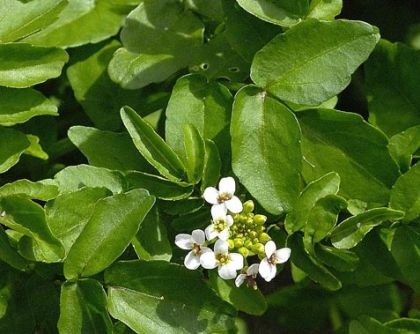This familiar hairless perennial lives near and in shallow streams and ditches throughout the country. It has shiny, dark green, pinnately divided leaves growing on branched stems which sometimes float and root in the mud. The white four petalled flowers (4–6 mm) are borne in terminal heads and bloom from June to September. The fruits are curved, narrow, long siliqua (13–18 mm) containing two rows of tiny seeds. This is a native plant, previously known as Rorippa nasturtium-aquaticum, and it belongs to the Brassicaceae family.
I first identified this plant growing in Shanganagh, Co Dublin in 1977 and photographed it at Blackhall Strand, Co Wexford in 2005.
If you are satisfied you have correctly identified this plant, please submit your sighting to the National Biodiversity Data Centre
This plant is said to contain significant amounts of iron, calcium, folic acid, Vitamins A and C but it is extremely important to know precisely what conditions it has been grown in as various parasites can inhabit the waters in which it grows in the wild. Watercress Soup is absolutely delicious and very nourishing, as are salads to which carefully sourced watercress is added.
In our folklore, it was deemed a cure for lunacy.
'It is said that if a person got mad and if he drank the waters of Tobar na nGealt and ate the watercress that is growing in the well, he would be cured of his madness.'
From the National Folklore Collection, University College Dublin. NFC 782:363. From Kerry. Tobar na nGealt is six miles east of Annascaul, Tom Crean's village on the Dingle Peninsula.
The 16th c. herbalist John Gerard recommended Watercress as a cure for scurvy and it was used in helping sailors' diets when away for long voyages.



